The winning architects and projects were presented to the press in Florence, Italy, by IMM president Giancarlo Tonini, the jury’s chairman, and CEO Paris Mozzani before the president of Confindustria Toscana, Sandro Bonaceto. “The scenario that comes to the forefront, according to the jury, is an intelligent, relevant use of marble and stone, which is used by our architects with master skills that come from centuries of experience,” said Tonini. “They deliver impressive results that help promote Italian materials and the excellent standards of our companies, which, when they have to make quality projects and fulfill the requirements of architects, have no rivals in the world and prove that their leadership is not down to chance.”
According to the regulations, the award is given to works in which stone has been used to “excellent” standards in one of the three major spheres of application:
· External Facings
· Interior Decoration
· Urban Landscaping
All of the winners, as well as the works that did not win but were particularly significant, were included in the official MAA catalog, which was presented at CarraraMarmotec 2007.
The award, which is organized by IMM in conjunction with ICE (Italian Trade Commission) and Toscana Promozione with the assistance of Cassa di Risparmio di Carrara, is sponsored by Pietra Autentica and Pietra Naturale.
Additional sponsors of the award include Associazione Italiana Marmomacchine, Campolonghi Italia, Henraux, Ezio Ronchieri, M.A.P. srl, Gemignani e Vanelli, Marmi Carrara, Sagevan Marmi, Società Apuana Marmi and Tonini & Donnini. The awards ceremony was held on June 2 during CarraraMarmotec 2007, where the winners explained the features and applications of marble in their works during a workshop.

Section I - External Facings - First Prize
Courthouse of Pescara, ItalyCompletion Date: 2002
Architects: Studio Giulio Fioravanti, Rome, Italy; Arch. Franco Agresta, Rome, Italy
Materials: White Carrara marble, Pietra Grigia Jugoslavian stone
Stone Supplier: Facciata Group, Carrara
Consultant for Stone Materials: Politecnico di Torino – Dipartimento di Tecnologia e Materiali, Torino
Stone Fabricator and Installer: Alfa Sistemi di Carrara - Carrara, Massa Carrara
Project Description: For the “External Facings” (Section I) category, the award was won for the Courthouse of Pescara, designed by studio Giulio Fioravanti and architect Franco Agresta of Rome. The project largely used White Carrara marble and gray stone from Yugoslavia in a work that, through a modern use of marble, looks minimal without detracting from the monumental proportions and starkness of the building.
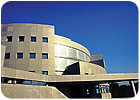
Section I - External Facings - Special Mention
Provincial Carabinieri Headquarters, Rieti, ItalyCompletion Date: 2003
Architect: Studio Prof. Arch. Manfredi Nicoletti, Rome, Italy
Material: Impala Nero-South Africa granite
Consultant for Stone Materials: Prof. Arch. Manfredi Nicoletti, Rome, Italy
Stone Supplier and Fabricator: GISM di Francesco Longo – Catania, Italy
Stone Installer: Gestecos (ex ATI Ing. Noni Ferrari Costruzioni Srl) – Rome, Italy
Project Description: Judges praised this work for “achieving, even in a military building, great architectural decorum that makes the most of the chromatic and functional features of granite.”
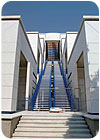
Section I - External Facings - Special Mention
New funeral building of the Monumental Cemetery of Milan, ItalyCompletion Date: 2004
Architect: Arch. Calogero Di Stefano, Palermo
Materials: White Carrara “C” marble, Bardiglio Imperiale marble, Verde Guatemala Indian marble, Beola Grigia stone, Serizzo Grigio granite
Stone Consultant for the Installation: GS Engineering S.r.l. – Massa Carrara, Italy
Stone Suppliers and Installers: Eredi Alessandro Ceccarelli s.a.s., Milan, Italy; Rigo Marmi S.r.l.; Milan, Italy
Stone Fabricator: Incomarbo, Massa, Carrara, Italy
Project Description: White marble, along with Bardiglio, Beola, Serizzo and Indian Green marble, give “a modern twist and great impact to a building that is set in powerfully symbolic surroundings.”

Section II - Interior Design - First Prize
Papa Giovanni XXIII Church and Pastoral Centre, Bergamo, ItalyCompletion Date: 2004
Architect: Studio Architetto Mario Botta, Lugano, Switzerland
Material: Rosso Verona marble
Stone Supplier: Fasani Celeste, Verona, Italy
Stone Fabricator and Installer: Sarcoberg S.r.l. Marmi Graniti Piastrelle, Bergamo, Italy
Project Description: In the “Interior Decoration” (Section II) category, first prize was won by Mario Botta, who designed Papa Giovanni XXIII Church and Pastoral Centre in Bergamo, in which the “Lugano-born master used Rosso Verona marble with his typical skills and scenic effects playing with the shades of this material.”
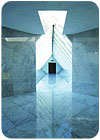
Section II - Interior Design - Special Mention
Hospital Chapel ofProspiano (Varese), Italy
Completion Date: 1997
Architect: Studio Architettura Moretti, Milan, Italy
Material: White Carrara marble
Stone Supplier, Fabricator and Installer: Italmarmi di Toniolo C. – Cairate, Varese, Italy
Project Description: A “Special Mention” went to Studio Moretti of Milan for the Hospital Chapel of Prospiano (Varese), where the use of white marble sets off “an extremely innovative pattern that was chosen for a place of worship set amidst earlier architectural features.
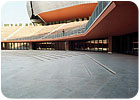
Section III - Urban Landscape - First Prize (tie)
Concert Hall, Parco della Musica, Rome, ItalyCompletion Date: 2002
Architect: Renzo Piano Building Workshop, Genova
Material: Trevi travertine
Stone Supplier: Travertini Giansanti S.r.l. – Guidonia, Rome, Italy
Stone Fabricator: Erregi travertino S.r.l. - Rome, Italy
Stone Installer: Geimar S.r.l. – Tavagrasso, Torino, Italy
Project Description: Renzo Piano designed the concert hall for Parco della Musica, completed in Rome in 2002. For this extremely modern work, Piano selected travertine, “the quintessentially Roman material.” Piano was praised for “giving universal dignity to a place of socialization, which is heavily marked by stone.”
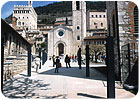
Section III - Urban Landscape - First Prize (tie)
Redevelopment of Piazza San Giovanni, Gubbio, ItalyCompletion Date: 2006
Architect: Gae Aulenti, Milano
Material: Firenzuola stone
Stone Supplier: Mariani S.r.l., Gubbio
Project Description: Gae Aulenti was responsible for the redevelopment of Piazza San Giovanni in Gubbio with lavish use of extra-hard Firenzuola stone. The jury stated that the material “gives a strong imprint to a public area, with great aesthetic dignity and a pleasant public use.”
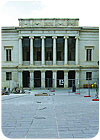
Section III - Urban Landscape - Special Mention
Redevelopment of Piazza Battisti, Carrara, ItalyCompletion Date: 2006
Architect: Studio Mangiarotti - Arch. Angelo Mangiarotti, Milano; with Arch. Mariano Billè e Arch. Renata Cussigh, Carrara
Materials: Firenzuola stone, Valcamonica porphyry
Stone Consultant: Baldini Srl, Carrara, Italy
Stone Suppliers and Fabricators: Berti Sisto, Florence, Italy (Firenzuola); F.lli Pedretti, Esine, Brescia, Italy
Project Description: A “Special Mention” for Urban Landscaping was given to Angelo Mangiarotti for the redevelopment of Piazza Battisti in Carrara (with the help of Mariano Billè and Renata Cussigh) where he used Firenzuola stone and Valcamonica porphyry. “By separating the shades of the different materials, he achieved an exemplary recovery of a downtown area, with a great, unique scenic effect -- giving back to pedestrian use an area that gives new dignity to the ancient Teatro degli Animosi of Carrara, completely paneled in white marble,” stated the jury.